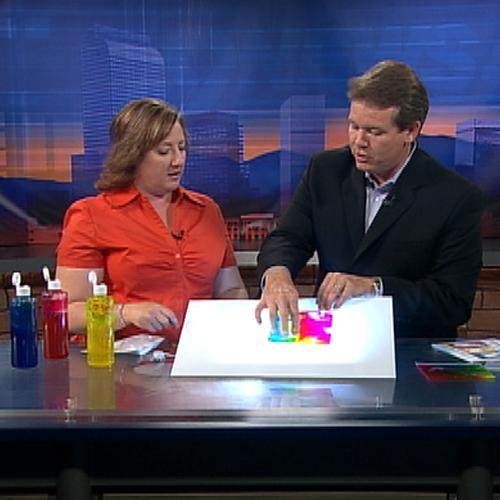Is it?… Can it be?… Why YES! There is an entirely new medium for mixing colors! Teachers worldwide have been blending primary colors into secondary colors using every medium possible since the dawn of time! They have had their students mixing and mashing everything from paints to play dough. But now it’s time for something different! It’s Squishy. It’s Gooey. It’s Pinch and Mix! When this colored goo is blended it resembles stained glass! This activity is sure to leave young and old alike pinching and blending to create unique fab-goo-lous art!
Pinch and Mix – Color Mixing
Combine science and literature using the book Mouse Paint

Experiment
- Squirt 1-2 tablespoons of each color goo into the zipper-lock bag. Aim for one color in each bottom corner and the third color in the bottom middle of the bag.
- Take care to gently squeeze as much air out of the bag as possible before sealing it. Then pinch and mix the goo to your heart’s content.
- Now, watch as the colors begin to blend from primary to secondary colors! The blue and yellow are becoming green, the red and yellow are turning orange, and the red and blue are blending into purple! Soon your bag will take on a soft, stained-glass effect.
But… anyone who has spent time with a child knows that they are not going to gently pinch the colors together slowly and revel in the beauty… NO they are going to grab that bag and after a nanosecond of gently mixing will squeeze and squish that bag of goo! Wait! Before you fuss that the activity is ruined, stop and hold that bag of squished up gel to the light. LOOK! The colors have created gorgeous swirling patterns! This activity offers a new twist to a time-tested experiment and is also great for strengthening the fine motor skills of small fingers.
Now Try This…
Dust off that old overhead projector to set up your own color mixing theater and bring a whole new level of WOW to the activity! Pinch and Mix the bags of goo while they are laying flat on the projector surface. Watch as you mix the goo for a brilliant show of color and light. No overhead projector… no problem! For a similar effect, try holding your bag of goo up against the window while you blend.
Now that you have mixed and mixed and mixed, you are wondering what to do with a bag full of dreary-colored goo. The answer is…. take the activity to the next level! Lay the bag of goo flat on the table. Smooth the goo evenly inside the bag. Now, use your finger as a writing tool and practice forming letters and numbers! No need for erasers with this writing tool, just smooth the goo inside the bag and begin again!
How Does It Work?
Not only does this Pinch and Mix activity help drive home the idea of primary colors blending into secondary colors, it offers so much more! It gives children that needed time to wonder, discover, and explore.
As soon as their bag becomes all one color the children are guaranteed to want to do it again! This time, predict what color your bag will be when you are finished mixing. Will it be brown, black, gray…? Why is it different each time?
The answer is in the balance of colors added to the bag. If you add more red and yellow than blue, your bag will become a shade of brown. If you use more blue than yellow and red and your bag will end up a shade of black.
So, how does this apply to real life, you ask? Where is color mixing found other than an artist’s studio? The answers are right outside your window! What happens when the sun appears during a rainstorm?…a rainbow!
Additional Info
If you browse the bookshelf in almost any early childhood classroom, you will find the book Mouse Paint by Ellen Stoll Walsh. Mouse Paint is a delightful story about three white mice who discover jars of red, yellow, and blue paint. Creativity ensues as the mice explore what happens when they begin to play in the puddles of paint. Wondrously, the three primary colors they began with become secondary colors as they play.
Now it is your turn to delight and discover. Begin by reading the story Mouse Paint. Discuss what the mice found and what happened after they were coated in one color paint and messed about in another color. Then make your own color connections by pretending you are little mice mixing the colors in your zipper-lock bag!
